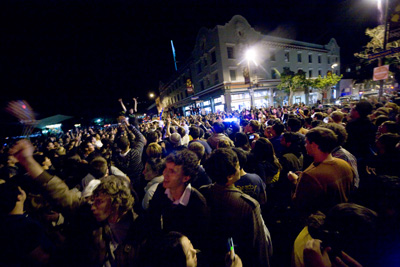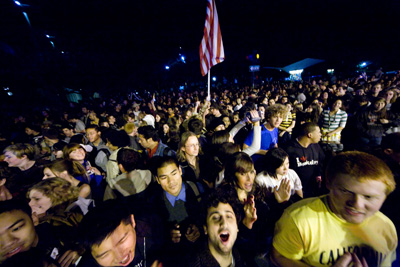So when I originally planned this article, it was a couple days after the November 4th election and all the craziness that ensued. So I suppose, more than a week after the actual inauguration, this isn’t exactly the most relevant anymore, but I’d like to hope that these photos (and whatever lessons gleamed from them) are somewhat timeless.
For the Daily Cal’s election night coverage, I was initially assigned to cover the results watching party held at the Institute of Government Studies (IGS) Library at Moses Hall. After I had gotten back to the office and was in the midst of sorting through and cutting down my images, we started hearing a crowd gathering outside. So most of the people in the office went over to the Bancroft-facing windows and found this:
Part II: Berkeley Street Celebration

Election night crowd on Bancroft
Like any good photojournalist, the next thing I did was to hop in the elevator and leap down into the fray.
Working the Ultrawide
When dealing with huge crowds and cramped spaces, your biggest friend will be an ultrawide lens. Usually you’ll want to show the vastness of the surrounding crowd, and most of the time that’s not quite possible with even a moderate wide-angle. Compare this shot, for example, which is taken at a 12mm equivalent:

Election night crowd at 12mm
To this crop of the same photo, which represents a 24mm equivalent (which is still a fair bit wider than the standard lenses most photogs use). In this second shot you get the sense that it’s very cramped and crowded, but that’s it. You don’t get any idea about the vastness of the crowd, and since there’s so many people around, they take up virtually the entire frame, leaving no room to see what exactly the context or the surroundings are.

Election night crowd at 24mm
The ultrawides also offer a few more advantages. Oftentimes in these situations you’ll be forced to simply hold the camera as high above your head as you can, and unless you’re equipped with live view and a rotatable LCD screen, there’s simply no way to see what exactly you’re getting. The technique here is to simply spray ‘n pray – set the camera on continuous high and just keep clicking away, with the hopes that at least one of the shots will be the actual framing you want. The ultrawide helps here by capturing more of the scene, thereby giving greater latitude in cropping down to the framing you actually want. Ultrawides are also a lot less susceptible to shake, which is useful for these low-light situations (although this advantage disappears if you start cropping in).
Attaining Focus
Before I get to my next point, here is a smattering of other crowd shots I took earlier on when I first got down to the street and started making my way through the crowd. Needless to say, these are the ones I didn’t even bother turning in to the editor.



The biggest issue with all of these images is that none of them have any particular subject that captures the viewer’s attention. All the viewer sees in these images is a huge collection of people. Beyond the existence of this very large mob, there is really very little information that these images reveal – why are all these people gathered here? what is the sentiment of the crowd – are they celebratory or riled in anger? Most of these images feature a fairly bland and random crowd (no real consensus of ethnicity or age or gender or dress style) and are taken far away enough that the facial expressions of the individuals aren’t easily noticeable, thus providing us no context whatsoever. If you weren’t viewing them here in the context of a photo blog about election night coverage, you wouldn’t be able to tell this crowd from a riotous mob taking to the streets, an organized political protest on the march, or perhaps even the sold-out crowd at some outdoor street concert?
From a journalistic standpoint, the last image here is the closest to what we want, even though aesthetically it may be the worst of the bunch. Nevertheless, this photo prominently features (somewhat) the faces of some members of the crowd up front; we can clearly see that they’re cheering and having a good time, which tells us this is a celebration of some sort. Furthermore the flag being held up in the background tells us that there is some element of politics or perhaps patriotism involved in this gathering. If the average viewer can put two and two together (perhaps in conjunction with the fact that this is running on the day after the election, near some headline related to the election), it becomes obvious that this is a crowd that is celebrating the election results, which isn’t something that’s very obvious in any of the other images.
Of course, this image isn’t perfect either. It’s not very interesting aesthetically; there’s not quite enough focus on the individuals up front (though this is a delicate balance between also showing enough context (i.e. the massive crowd behind them)); and since the background is basically pitch black, we don’t have a clue where the heck we are.
So as I was taking and reviewing my shots in the field, surrounded by this crowd, I began to realize how fruitless my current approach of spray ‘n pray to get a good variety of crowd shots was – no matter where you’re pointing the camera, the endless sea of nondescript people will look the same everywhere, which doesn’t provide much variety at all. My focus turned to picking out elements that would stick out from the crowd and provide a good focus for the viewer.
I found my subject in the form of a parked police car at the Bancroft and Telegraph intersection. The crowd had essentially encircled it, but there really wasn’t much going on – the officer was mostly just standing there by his car and occasionally stopping the overzealous individual from hopping on it. Other than that there was really very little interaction – the police car simply served as an interesting visual element to break up the monotonous sea of people. Here are the two images I ended up bringing back (take a guess at which one ended up printed on the front page?)

Election night crowd - girl and flag

Election night crowd - police car
The first shot here has basically all the elements we’re looking for. The aesthetic is there – we have some clear subjects in the cheering girl, the flag, and the police car to draw the viewer’s attention and tell us about the nature of the people here and what they’re doing. We also still see plenty of the vast crowd, and the ultrawide angle gives us a view down Bancroft and Telegraph, which provides the scene-setting context. Everything about the event (who was there, what they were doing, where it happened) can pretty much be told by this photo.
The second photo actually isn’t all that much different from the first few photos. Sure there’s a waving flag (although it’s not really as prominent here as in previous ones), but otherwise a fairly nondescript crowd for which we have no idea what they’re doing here. The image does have an aesthetic draw, which is the police car, and the officer talking with some members of the crowd, but in the grand scheme of this celebration, this basically amounts to a photographic non sequitur. There wasn’t anything special about the car or the officer – they didn’t participate or interact with the crowd; they were just there, and showing the viewer that a police officer was at the scene doesn’t tell them anything at all about the event (it may even be misleading, depending on how deeply a viewer reads into it).
It turns out the second image was chosen anyway, which I sort of chalk up to a case of aesthetics winning out over storytelling. Sometimes that happens, but in any case I think this is a pretty good example demonstrating the differences between covering the event as a regular photog (looking for the best-looking image) and covering the event as a photojournalist (looking for the most comprehensively descriptive image, usually). Sometimes you’ll have to sacrifice aesthetics in order to tell a more accurate or more complete story. And sometimes the image with better aesthetics will run anyway, if it tells the story “good enough” (which I don’t necessarily disagree with – readers will get bored if you simply run the safe, descriptive image every time).


I found Nathan!